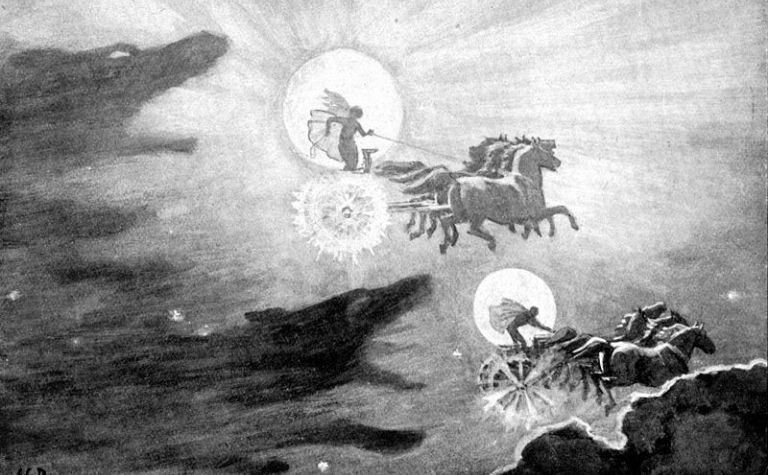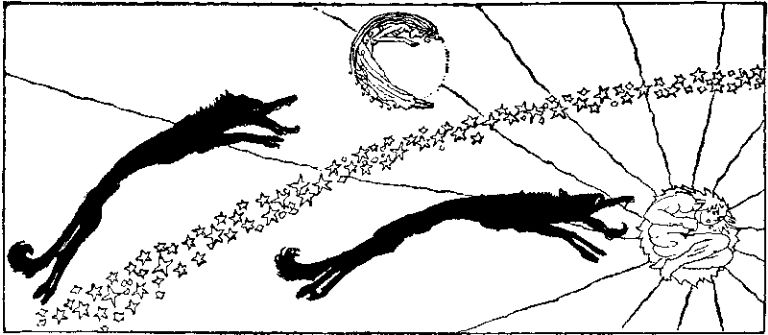Skoll and Hati are two of the most fascinating characters in Norse mythology. Their nature and actions are intriguing and mysterious.
Sköll and Hati are mentioned in stories about Odin, Ragnarok, and many others.
In the original Norse myths, Sköll and Hati are two giant wolves who chase the moon (Mani) and sun (Sol).
They are children of Fenrir, and at Ragnarok, they are prophesied to devour the sun, plunging the world into darkness.
Sköll and Hati aren’t mentioned very much in Norse mythology, and what we know is sometimes contradictory.
But that hasn’t stopped them from appearing in art, pop culture, jewelry, tattoos, and more. Keep reading to learn more about these celestial wolves and their role in Norse mythology.
Also, see Norse Mythology vs Greek Mythology: What’s the Difference? to learn more.

Are Sköll and Hati Related to Fenrir?
Even if you hadn’t heard of Sköll and Hati before, you’ve probably heard of Fenrir, another giant wolf in Norse mythology.
Fenrir is the son of Loki, a trickster god, and the giantess Angrboda.
Fenrir is notable for being chained by the gods until Ragnarok and for biting off the arm of the war god Tyr.
Fenrir is the father of Sköll and Hati, according to the Poetic Edda, which refers to them as brothers and later to Hati as Hróðvitnir’s (the “famous wolf’s”) son.
The relationship between the three appears to be complicated. Sköll and Hati might be extensions of Fenrir instead of his children.
It makes sense that Fenrir, Sköll, and Hati might be related. They’re all giant wolves with important roles in Ragnarok.
But the lack of written sources about Norse mythology makes it difficult to say exactly how these three wolves are related.
One poem of the Edda says that “the son of Hrothvitnir, | Hati, awaits / the burning bride of heaven.” [1]
Hrothvitnir means famous wolf or mighty wolf, and the same name is used to describe Fenrir elsewhere in the Edda. This passage suggests that Fenrir is Hati’s father.
Because Sköll and Hati are rarely mentioned separately, it’s a safe assumption that Fenrir is also Sköll’s father.
Another poem from the Edda describes “the brood of Fenrir.” One of these children “was soon to steal | the sun from the sky.” [2]
Fenrir has a child who will swallow the sun. Hati or Sköll chases the sun (sources differ on which wolf chases which celestial body), so Fenrir is probably the father of one or both of these wolves.
Also, see Valhalla in Norse Mythology: 10 Facts to learn more.

Are Sköll and Hati Norse Gods or Something Else?
Who counts as a “god” in Norse mythology and who doesn’t is a complicated subject. Norse mythology is filled with powerful and otherworldly creatures, but they don’t seem to be gods.
These creatures include the serpent Jormungadr, the eight-legged horse Sleipnir, the squirrel Ratatoskr, and wolves like Sköll and Hati.
Sköll and Hati aren’t technically considered gods. Through both their father’s and mother’s lines, they descend from the giants rather than the Aesir or Vanir gods.
In today’s language, they’d more likely be considered monsters.
Most figures from Norse mythology that we call “gods” are from the Aesir family, including Thor, Odin, Baldr, and Tyr.
A few others are from the Vanir group, like the twins Frey and Freya. The Aesir gods were largely good and orderly, in contrast to the chaotic giants.
The conflict between the Aesir and the giants appears throughout Norse mythology.
It will come to a head in Ragnarok when the giants and monsters, led by Loki, will attack the Aesir, and most of the warriors on both sides will die.
Sköll and Hati are descended from Fenrir, the child of two giant parents, Loki and Angrboda. Meanwhile, the Norse representations of the sun and moon, Sol and Mani, are Aesir gods.
The ancient civilizations who worshipped the Norse gods probably didn’t consider Sköll and Hati gods. There’s no evidence that they were worshiped or regarded anything like the Aesir.
Also, see Fenrir: The Fascinating Wolf of Norse Mythology to learn more.
What Happens to Sköll and Hati?
Sköll and Hati have very few mentions in Norse mythology. There are no surviving stories that feature these two wolves, just a handful of mentions throughout the verses.
What we know happens to Sköll and Hati can be summarized in a few lines:
Sköll and Hati will continue to chase the sun and the moon through the sky until Ragnarok (the end times of the gods).
At that point, one or both of the wolves will swallow the sun and plunge the world into darkness.
Scholars of Norse mythology can’t even agree on which wolf chases the sun. In Snorri’s prose Edda, he says that Sköll chases the sun and Hati, the moon. But the poetic Edda suggests it’s the other way around.
It says Sköll “follows the glittering god” while Hati chases “the burning bride of heaven.” (The Norse viewed the sun as feminine and the moon as masculine.) These accounts seem to be at odds with each other.
And when Ragnarok comes, it’s unclear which wolf is supposed to swallow the sun or if it’s both. It appears that the distinction between the two wolves wasn’t very important.
Sköll and Hati were important to the Vikings because they could explain the movements of the sun and moon and eclipses. Plus, they were a giant counterpart to the Aesir Sol and Mani.
Also, see Can Ragnarok Be Stopped in Norse Mythology? to learn more.
Why Do People Get Tattoos of Sköll and Hati?
Everyone gets tattoos for their own reasons. But several factors inspire many people to get tattoos of Sköll and Hati.
People get tattoos of Sköll and Hati for their aesthetic appeal, symbolism, and thematic ideas. The wolves resemble Yin and Yang, light and darkness, and the cycle of day and night.
Wolves are popular tattoos, as are the sun and moon.
Wolves evoke both loneliness and partnership or pack mentality. They look fearsome and powerful.
On the other hand, the sun and moon represent change, stability, nature, and duality. Sköll and Hati are the perfect combinations of these images.
A tattoo of Sköll and Hati can serve as an artistic reminder of the duality of man. Or the tattoo could be a neat way to combine someone’s favorite animal with elements of outer space.
The reasons for choosing a tattoo are as varied as the people receiving the tattoos.
Conclusion
Sköll and Hati are fascinating characters, despite having few appearances in mythology. With all their thematic implications, it is no wonder they are still popular.
